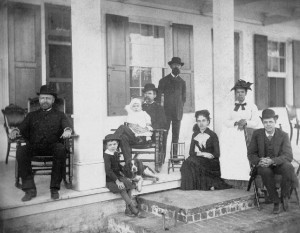Creator: Warmoth, Henry Clay, 1842-1931.
Collection number: 752
View finding aid.
Abstract: Henry Clay Warmoth, Louisiana governor, 1868-1872, and later owner of Magnolia Plantation, was born in Illinois in 1842. During the Civil War, he was lieutenant

colonel of the 32nd Missouri Volunteers, assigned to the staff of General John A. McClernand. He was wounded in 1863 near Vicksburg, but returned to his command after being cleared of spreading false rumors about the strength of the Union Army. Post-war, Warmoth was judge of Provost Court in New Orleans, and, in 1868 at age 26, was elected Republican governor of Louisiana. His governorship was dominated by issues such as civil rights, suffrage, election fraud, party factionalism, and corruption. In 1872, Warmoth faced impeachment charges for official misconduct, but his trial ended when his term as governor expired. He served in the Louisiana legislature, 1876-1877, and ran unsuccessfully for governor in 1888. Warmoth was Collector of Customs for the Port of New Orleans, 1889-1893. Beginning in 1874, Warmoth owned Magnolia, a Plaquemines Parish sugar plantation where he modernized sugar refining. Warmoth published “War, Politics, and Reconstruction: Stormy Days in Louisiana” in 1930 and died in New Orleans in 1931. The collection includes correspondence and diaries related to Warmoth’s service in the Union Army, his tenure as governor of Louisiana during Reconstruction, and political affairs in Louisiana. Topics discussed include civil rights; the Freedmen’s Bureau; the Fourteenth Amendment; suffrage for Louisiana freedmen; segregation on railroads; opposition to President Grant; violence in Louisiana; elections and election fraud; the Republican Party, both local and national, and party factionalism; management of the United States Mint in New Orleans; and the construction of railroads, levees, and canals. There are also letters, diaries, plantation journals, daybooks, ledgers, slave lists, and scrapbooks related to Magnolia Plantation, sugar refining, investment in railroads, and his service as Collector of Customs for the Port of New Orleans, 1889-1893. The 1865-1867 diary provides an eye witness account of the New Orleans Race Riot of 30 July 1866. Photographs depict Warmoth and his family; structures, machinery, and workers at Magnolia Plantation; and other scenes and individuals. Frequent and notable correspondents include Henry C. Dibble, Thomas Jefferson Durant, Charles Foster, Francis J. Herron, William Pitt Kellogg, Effingham Lawrence, W. L. McMillan, Stephen B. Packard, P. B. S. Pinchback, John R. G. Pitkin, Lionel A. Sheldon, George A. Sheridan, J. H. Sypher, J. R. West, and H. W. Whittlesay. There are also a few letters from presidents Benjamin Harrison, William McKinley, and William H. Taft, as well as a few letters from notable Civil War generals such as Benjamin F. Butler, James Longstreet, and John A. McClernand, and an 1868 letter of warning to Warmoth from the Ku Klux Klan.
Repository: Southern Historical Collection
Collection Highlights: The collection includes lists of enslaved individuals in the early days of Magnolia Plantation (Folder 2). Early papers also include mention of Barthelemy Baptiste, a “free mulatto” (Folder 1).
Civil war correspondence includes 9 July 1865 letter from H. W. Whittlesay stationed along the Rio Grande in which he discussed the merits of Mexican troops and African American troops. Of the Mexican troops, Whittlesay noted that they “like to measure swords with us.” Of the African American troops, he wrote, “[T]hey are not so subordinate as the plantation negros of the South” (Folder 7).
Post Civil War correspondence discuss the Freedman’s Bureau, the harassment of freedman, suffrage, and the problem of lingering secessionism in Louisiana (Folder 8 & 10). There are also letters mentioning problems with registering African American voters, including intimidation at the polls by whites (Folder 11).
Also included is a 27 April 1868 letter of warning to Warmoth from the Ku Klux Klan proclaiming “Blood, Blood, Blood. Prepare, Death Now Awaits You!” (Folder 14).
Reconstruction correspondence in 1871 includes discussions about segregation and African Americans on the railroad, where Warmouth urges no distinction made by race on rail accommodations (Folders 31 & 32).
There is also correspondence with African American politician P.B.S. Pinchback throughout the collection (Folders 33, 46, 64).
A 5 April 1930 letter from the Regular Democratic Organization of Louisiana ends with the valediction, “Yours for white supremacy.” (Folder 110).
Early journals from Magnolia Plantation contain lists of enslaved individuals, and also discuss the effect of the Civil War on their lives (Folder 120 and Oversize volume SV 752/2 and 3).
In his diary, Warmoth provides an eye witness account of the New Orleans Race Riot of 30 July 1866 (Folder 126). There are several clippings discussing Warmouth, politics, and race (Folder 187).
Photographs include the Warmouth family with two unidentified African American women, and (Image P-752/49) and another member of the Warmouth family with an “all black army (Image P-752/51). The family photograph has been digitized and is available online. Click here to link to the finding aid for this collection and to access the digitized content.
